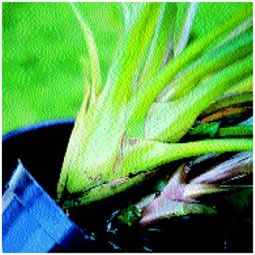Bromeliads are native to tropical America. Many are epiphytes, that is they live on other plants but do not parasitise those plants. Rather than growing in soil, they are found up in the forks of tree branches, surviving mainly on the moisture and nutrients they obtain from the air. Bromeliads can be quite spectacular grown in the garden, but they also make very good pot plants. The most familiar member of this interesting group is the pineapple! They are available in a wonderfully wide variety of sizes, shapes and foliage colours and can be grown outdoors in most areas of Australia. So they can be used to help you achieve a great tropical look in your garden even if you live well south of the tropics.
Bromeliads are available from most nurseries for between $10-$30 and upwards, and for the home gardener, division is the easiest method of propagation.
1. New plants can easily be grown from offsets (also called pups). When the offsets are about 15cm (6″) in size, just cut them away from the mother plant with a clean, sharp knife.
2. After thinning out the clump, pot up the adult plants and pups. Bromeliads require a light, open mix with good drainage. I suggest a 50:50 mix of standard orchid compost and ordinary potting mix. Before adding the potting mix, put a few pieces of broken pipe around the drainage holes to stop soil falling out and making a mess on any paving.
3. When potting don’t forget that the leaves hold water, so keep the central cup upright. This reservoir in the centre of bromeliads provides the plant with both water and nutrients.
4. Bromeliads do best in filtered light, and they don’t like strong fertilisers. If you want to fertilise, apply a very weak solution of a liquid fertiliser such as Nitrosol, perhaps mixed with Seasol.



